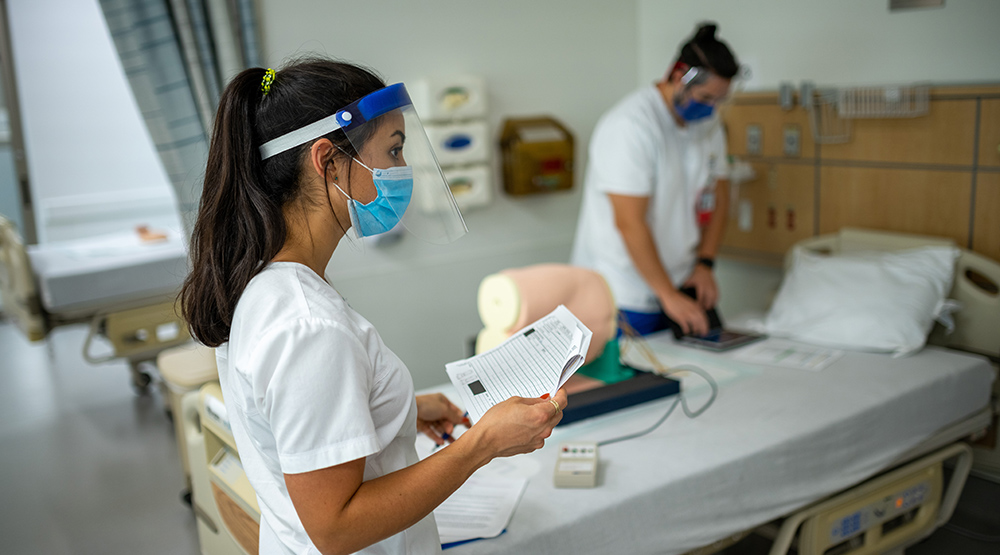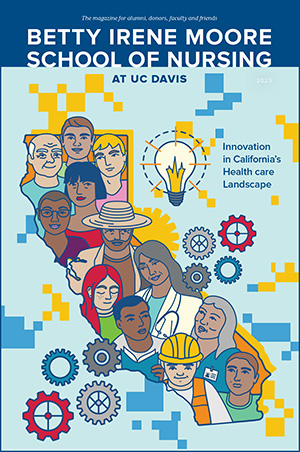Is simulation training in nursing education equitable?
New research explores underrepresented students’ inclusion and faculty strategies

Master’s Entry Program in Nursing students participate in simulation experiences throughout the 18-month program.
Before new nurses ever interact with a patient at the bedside, chances are they’ve spent some hours in simulation training. These encounters that mimic the real thing are proven to increase nurses’ confidence and improve patient outcomes.
With significant attention paid to diversity in health care, simulation specialists at UC Davis Health focus on creating diverse environments. They consider skin tone, age, sex and clinical setting in the actors who play patients and case scenarios, as well as in manikins, realistic models of the human body that are used in simulations. But what about consideration of how students from diverse backgrounds experience simulation coursework?
“Students bring many perspectives and life experiences to the simulation experience, many not visible to the instructor, but that can have a significant impact on what and how well they learn,” said Amy Nichols, associate dean for academics at the Betty Irene Moore School of Nursing at UC Davis. “We should optimize their ability to be excellent and diverse providers and we can do that by allowing them to be their real selves and learn in supportive environments.”
Diverse learners require different approaches
Nichols and a team of School of Nursing faculty received the Ruth Donnelly Corcoran Research Award from the National League for Nursing for their study, “Exploring Inclusive Teaching Practices During Simulation Experiences.” The $30,000 grant allows them to determine in what ways students' experiences and instructors' perceptions of simulation inclusiveness compare and differ.
“The purpose of this study is to explore whether the strategies that health professions educators engage in during simulation are inclusive of underrepresented, underserved or marginalized students,” said Jessica Draughon Moret, principal investigator of the study and assistant professor at the school. “To fully appreciate the value of inclusion, it’s important to understand the impact of marginalization and exclusion on student learning and well-being.”
Simulated exercises versus real patient experiences

Piri Ackerman-Barger, left, and Jessica Draughon Moret explore whether the strategies educators engage in during simulation are inclusive.
“Microaggressions are those daily slights and indignities that people from a stigmatized group experience based on their identity,” explained Associate Dean for Health Equity, Diversity and Inclusion Piri Ackerman-Barger. “If you’re put in a position to confirm a stereotype about your cultural group, energy diverts away from the frontal lobe of the brain. It can affect short-term memory, the ability to process information and intellectual performance.”
Ackerman-Barger brings her combined expertise in nursing and education to advance inclusive learning environments, education equity and workforce diversity. Director for Clinical Simulation Jennifer Edwards partners with faculty in the development and delivery of simulations and implementation of best practices.
A steppingstone to better understanding
“Health care simulation accrediting bodies are starting to include mention of diversity and inclusion in their guidelines, but little research has been published on their implementation or impact on the lived experience of students or faculty during simulations,” Edwards said. “This work begins to explore the important question of, ‘how are we doing?’ in terms of diversity and inclusion efforts in simulation and builds a steppingstone for deepening our understanding and ideally improving our practice.”
In partnership with the California Simulation Alliance, the team, which includes alliance director KT Waxman from UCSF, conducts a mixed methods study including cross-sectional surveys of prelicensure nursing students and faculty engaged in simulation. They follow those with in-depth semi-structured interviews to better understand mismatches in student and faculty perceptions. This lays the foundation for development of best practices in creating inclusive simulation learning environments and experiences.
“My long-term hope is that faculty realize we have a lot more diversity work to do. What they’re doing is great, but it’s just the tip of the iceberg,” Nichols said. “I sincerely hope that we can gain insight in how best to support students from historically marginalized backgrounds through all aspects of simulation learning experiences.”





